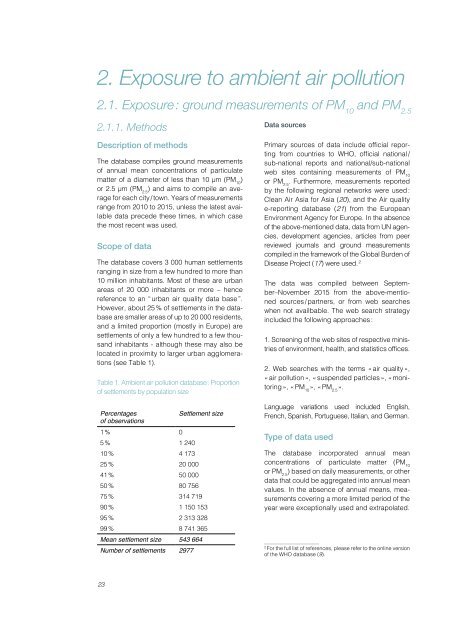Ambient air pollution A global assessment of exposure and burden of disease
9789241511353-eng
9789241511353-eng
You also want an ePaper? Increase the reach of your titles
YUMPU automatically turns print PDFs into web optimized ePapers that Google loves.
2. Exposure to ambient <strong>air</strong> <strong>pollution</strong><br />
2.1. Exposure : ground measurements <strong>of</strong> PM 10<br />
<strong>and</strong> PM 2.5<br />
2.1.1. Methods<br />
Description <strong>of</strong> methods<br />
The database compiles ground measurements<br />
<strong>of</strong> annual mean concentrations <strong>of</strong> particulate<br />
matter <strong>of</strong> a diameter <strong>of</strong> less than 10 μm (PM 10<br />
)<br />
or 2.5 μm (PM 2.5<br />
) <strong>and</strong> aims to compile an average<br />
for each city / town. Years <strong>of</strong> measurements<br />
range from 2010 to 2015, unless the latest available<br />
data precede these times, in which case<br />
the most recent was used.<br />
Scope <strong>of</strong> data<br />
The database covers 3 000 human settlements<br />
ranging in size from a few hundred to more than<br />
10 million inhabitants. Most <strong>of</strong> these are urban<br />
areas <strong>of</strong> 20 000 inhabitants or more – hence<br />
reference to an “ urban <strong>air</strong> quality data base ”.<br />
However, about 25 % <strong>of</strong> settlements in the database<br />
are smaller areas <strong>of</strong> up to 20 000 residents,<br />
<strong>and</strong> a limited proportion (mostly in Europe) are<br />
settlements <strong>of</strong> only a few hundred to a few thous<strong>and</strong><br />
inhabitants - although these may also be<br />
located in proximity to larger urban agglomerations<br />
(see Table 1).<br />
Table 1. <strong>Ambient</strong> <strong>air</strong> <strong>pollution</strong> database : Proportion<br />
<strong>of</strong> settlements by population size<br />
Percentages<br />
Settlement size<br />
<strong>of</strong> observations<br />
1 % 0<br />
5 % 1 240<br />
10 % 4 173<br />
25 % 20 000<br />
41 % 50 000<br />
50 % 80 756<br />
75 % 314 719<br />
90 % 1 150 153<br />
95 % 2 313 328<br />
99 % 8 741 365<br />
Mean settlement size 543 664<br />
Number <strong>of</strong> settlements 2977<br />
Data sources<br />
Primary sources <strong>of</strong> data include <strong>of</strong>ficial reporting<br />
from countries to WHO, <strong>of</strong>ficial national /<br />
sub-national reports <strong>and</strong> national/sub-national<br />
web sites containing measurements <strong>of</strong> PM 10<br />
or PM 2.5<br />
. Furthermore, measurements reported<br />
by the following regional networks were used :<br />
Clean Air Asia for Asia (20), <strong>and</strong> the Air quality<br />
e-reporting database (21) from the European<br />
Environment Agency for Europe. In the absence<br />
<strong>of</strong> the above-mentioned data, data from UN agencies,<br />
development agencies, articles from peer<br />
reviewed journals <strong>and</strong> ground measurements<br />
compiled in the framework <strong>of</strong> the Global Burden <strong>of</strong><br />
Disease Project (17) were used. 2<br />
The data was compiled between September–November<br />
2015 from the above-mentioned<br />
sources / partners, or from web searches<br />
when not availbable. The web search strategy<br />
included the following approaches :<br />
1. Screening <strong>of</strong> the web sites <strong>of</strong> respective ministries<br />
<strong>of</strong> environment, health, <strong>and</strong> statistics <strong>of</strong>fices.<br />
2. Web searches with the terms « <strong>air</strong> quality »,<br />
« <strong>air</strong> <strong>pollution</strong> », « suspended particles », « monitoring<br />
», « PM 10<br />
», « PM 2.5<br />
».<br />
Language variations used included English,<br />
French, Spanish, Portuguese, Italian, <strong>and</strong> German.<br />
Type <strong>of</strong> data used<br />
The database incorporated annual mean<br />
concentrations <strong>of</strong> particulate matter (PM 10<br />
or PM 2.5<br />
) based on daily measurements, or other<br />
data that could be aggregated into annual mean<br />
values. In the absence <strong>of</strong> annual means, measurements<br />
covering a more limited period <strong>of</strong> the<br />
year were exceptionally used <strong>and</strong> extrapolated.<br />
2<br />
For the full list <strong>of</strong> references, please refer to the online version<br />
<strong>of</strong> the WHO database (9).<br />
23



